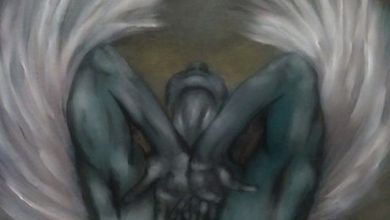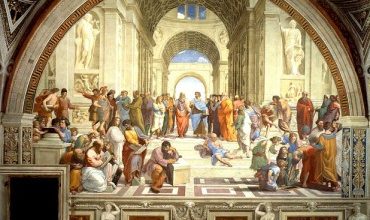
Crossing the Bar : The poem
Composed by Tennyson in 1889, three years before he died, Crossing the Bar is an intensely personal poem which engages with the themes of old age, faith, doubt, life and death. It is said to have been written by Tennyson in a single sitting while he was crossing the Solent from Aldworth to Farringford, at a point in his life when he had just escaped a near-fatal illness. Rich in its symbolism and consistent with Tennyson’s oeuvre, Crossing The Bar uses the image of a sandbar lying between the shore and the vast ocean as symbolic of the juncture between life and death. The symbols of the sea, the sandbar, the night and the idea of sailing are delicately interwoven to explore the ideas of life, old age, death and hope.
This sixteen lined poem is composed of four quatrains, each following an abab rhyme scheme. Tennyson’s astute sense of rhythm and his ear for melody finds its controlled expression in this poem. Crossing the Bar uses the example of the sandbar from where the journey from life to the afterlife takes place. However, this transition isn’t marred by sadness but is tinted with a sense of tranquil optimism with which the speaker hopes to meet his maker.
A short note on Sandbars
A crucial step in understanding the poem is to fully grasp the implications of the nature and significance of a bar as is used in the poem. Also known as a sandbar or a shoal, a bar is a land formation near a bay, a shore or any area in the sea or gulf with lower levels of water. Sandbars are dangerous places for ships and sailing. These barely submerged landforms treacherously resurface in low tides and do to ships pretty much what the iceberg did to the Titanic. This is because the lack of buoyancy, the weight of the ship and the constant battering of the waves destroy the unlucky ships in no time if they happen to get stuck on a sandbar. Sandbars had a notorious reputation in seafaring Victorian England and landing on one meant death by drowning, injury or slow starvation. The bar wasn’t just another feature of the sea and crossing the bar wasn’t just an option. It was a necessity. The bars are safe to cross only during the high tides when they are submerged. Low tides often result in the resurfacing of the sandbar which is as good as a brick wall for the sailing ships. This fact becomes significant when Tennyson writes about the high tides and low tides of religious faith. Tennyson has thus carefully chosen the subject of his poem and is distilling in simple words a host of complex ideas of the physical and spiritual nature. This understanding of the nature of a sandbar is crucial for a sound analysis of the poem, hence this short note.
Got No Time? Check out this Quick Revision by Litbug
Crossing The Bar : Summary and Analysis
Crossing The Bar | Stanza 1
Sunset and evening star,
And one clear call for me!
And may there be no moaning of the bar
When I put out to sea,
The poem opens on a somber note of an inevitable ending. The sunset is accompanied by an evening star, heralding the night. The day is dying. This death of the day is imbued with great significance as the poet finds it all too relatable. Remember, Tennyson wrote this poem three years before his death when his health was rapidly deteriorating. He hopes there will be no ‘moaning of the bar” when he moves towards the sea.
On a literal level, the ‘moaning‘ refers to the sound made by the sea waves as they come crashing on the sandbar. Such a phenomena occurs when the tide is low and the bar has resurfaced. As mentioned earlier, an open sandbar is one of the most dangerous objects a ship can run into. It means disaster. It is only natural then that the speaker doesn’t wish to hear the moaning of the bar when he sets out for sea. Symbolically, it reflects the pain which accompanies one when crossing from one realm to another, from life to afterlife as indicated by the use of ‘sadness of farewell ‘ in the third stanza. The poet hopes that the sandbars of despair do not rise to stop him from going back to his home which is the sea of eternity.
The third line of the stanza uses a marine term (call) which refers to the announcement for the sailors and seafaring men to set out. This literal meaning of the call is entwined with the symbolic significance of the impending announcement of the poet’s departure from the present world to the next.
To analyze the poem metrically, one look at the poem makes it clear that it doesn’t have one particular meter but rather uses a combination of dimeters, trimeters and tetrameters which is employed in a particular, recurrent pattern as will be seen below:
Sunset and evening star, ( iambic dimeter)
And one clear call for me! (iambic trimeter)
And may there be no moaning of the bar(iambic pentameter)
When I put out to sea, (iambic trimeter)
Permutations and combinations of these different meters is employed throughout the poem which produces a series of rhythmic troughs and crests thus effectively mimicking the movement of the sea waves. The ebb and flow of the lines of this sea-based poem testifies of Tennyson’s poetic sensibilities in creating a harmony between form and content .
Crossing the Bar | Stanza 2
But such a tide as moving seems asleep,
Too full for sound and foam,
When that which drew from out the boundless deep
Turns again home.
Tennyson’s poems have characteristically dealt with life as a journey, whether it be in his poems like Ulysses or his masterpiece In Memoriam. A journey ( such a tide as moving) as great as one from life to death carries with it a dignity of depth that doesn’t draw attention to itself through noise but is instead a quiet return (seems asleep) for it is too full for “sound and foam”. As can be understood, it is only a full tide which is able to bear one across the sandbar and towards the ocean. It is only the high tide of faith which will submerge the sandbar and allow him to move towards the sea. Tennyson’s obsession with religion and the accompanying insecurities around it was characteristic of the age he was living in.
Similarly, the idea of depth has played a huge role in Tennyson’s poetry. From one of his earliest poems such as The Kraken , featured in his first published collection of poems to works like In Memoriam written during his heights of maturity, the idea of depth finds a recurrent place in his poetry. The transition from life to death has a great significance. It is too deep and weighty to create froth and foam- superficial things that have more sound than substance. These elements have no place in the journey where one’s life “draws from out the boundless deep” of eternity and turns again to where it came from. The phrase “turns again home” in this stanza shows the waves as originating from the boundless ocean, briefly touching the shore only to return again to the depths of eternity. The unknown eternity of the “boundless deep ” is the home of the soul which must cross the bar to reach there. The Christian notion of the ephemeral nature of life and the eternal afterlife which is the true home of the soul is visible in these lines. The image of the immensity of the deep water currents that begin from the sea and return to it in a quiet and grand manner creating “no sound and foam ” is truly Tennysonian.
Crossing The Bar | Stanza 3
Twilight and evening bell,
And after that the dark!
And may there be no sadness of farewell,
When I embark;
The transition from twilight to the darkness of the night is complete in this stanza, signaled by the evening bell. Th evening bell is also symbolic of the knell which is sounded when someone dies. The phrase “sunset and evening star” of the first stanza is replaced by “twilight and evening bell” of this stanza. Time has passed by since the speaker began the poem and time is passing by as he speaks which imbues the line with a sense of urgency. The evening and the sunset is also symbolic of the old age he is in. He is inching towards the inevitable. The evening bell is accompanied by the acknowledgement of what is to follow : And after that the dark!
This stanza also makes explicit the personal note the poet reveals when he hopes there will be “no sadness of farewell” when his time is up.
Crossing The Bar | Stanza 4
For tho’ from out our bourne of Time and Place
The flood may bear me far,
I hope to see my Pilot face to face
When I have crost the bar.
The physical world that we inhabit is referred to as the “bourne of Time and Place “. The poet knows that the flood will take him far from the bourne of Time and Place and he hopes to see his Creator (Pilot) face to face when he has crossed the bar.
The flood can be viewed as being a representation of one’s faith, the high tide of faith which will drown the dangerous sandbar and help him sail away. Notice, it is only the ‘flood‘ of a high tide which will bear him far away from the treacherous sandbar of despair. So is he praying for courage to have faith enough to cross the bar?
The idea of seeing the creator face to face is also found in the book of Corinthians which describes the certainty of meeting the Creator face to face in the afterlife:
For now we see in a mirror, darkly; but then face to face: now I know in part; but then shall I know fully even as also I was fully known
Also, the use of the term Pilot is of great importance. The idea of God being the Pilot of one’s ship is a recurrent theme in Christianity . In seafaring Britain, the Pilot was also a person who detected the deceptive sandbars and guided the sailors to a safer route towards the sea. Again, the intermingling of the physical and the spiritual realm becomes evident.
Crossing the Bar is a classic example of a poem which shows the interplay of a theme which most widely captured Victorian thought : Faith and Doubt.
The speaker says that though the flood may bear him far, he hopes to see his Pilot face to face when he has crossed the bar. Does this mean that the Christian faith of Tennyson remained intact despite the rational onslaught of scientific thought in the Victorian Age? We see a degree of certainty in the tone of the speaker insofar as his fate is concerned E.g. “when I put out”, “when I have”, “when I embark“. If one pursues this train of thought, the last lines of the poem seems to resound with Christian optimism.
I hope to see my Pilot face to face
When I have crost the bar.
So, does the poem end on an assertion of faith? Or is there more to this than meets the eye? The sense of certainty we have seen so far seems to be the certainty of the inevitable, not of the afterlife. In all instances, the definitive “When I” is followed by “put out to sea“, “embark” and “have crost the bar” all of which effectively translate to death. It is the certainty of death, not the assurance of an afterlife. Furthermore, this element of certainty is missing in the last lines which deal with meeting the Pilot. Interestingly, the vocabulary of certainty (when I , I shall, / will etc.) is replaced by the the word hope. It is ” I hope to see my Pilot. It isn’t I will see my Pilot in this case. The certainty is in crossing the bar (when I have crost the bar), not in seeing the Pilot. There is only a hope of seeing the Pilot face to face. Everything then hinges on the interpretation of the word hope. Is it optimism or is it uncertainty? Does he rest in hope or does he resort to hope? Tennyson had requested that Crossing the Bar should be placed towards the end of every collection of his poems. And it is towards its end that the poem, like the sea waves, beings to slip away from our grasp and the sandbar becomes difficult to locate. Have we crossed the bar ? Or has the bar crossed us?
With its gentle rhythm and rich symbolism, Crossing The Bar is a deeply engrossing poem that makes us contemplate the mortal nature of man which will eventually have to cross the bar.
Crossing The Bar : About the poet
Hailed as the representative poet of Victorian Age, Lord Alfred Tennyson was born on 6th August 1809 in Lincolnshire and was the fourth child in the family. Tennyson’s father, the eldest child in the family had been disinherited by his father owing to which be harbored great resentment against his younger siblings. This, aggravated by his alcoholism adversely affected Alfred Tennyson’s childhood. Add to this, the strain of epilepsy ran across the Tennysons : one of his brothers was admitted to a mental asylum and another was an opium addict which lead Tennyson doubt his own sanity. Thankfully, he was able to get away from home and join the Trinity College, Cambridge in 1827. Tennyson had displayed artistic promise since he was a child, penning a 6000 line epic poem at the age of 12. His creative talents found a much needed outlet in Trinity where he joined a clique of literary enthusiasts who called themselves the Apostles. Tennyson also won the Chancellor’s Medal for his poem Timbuktu while at Cambridge. More importantly, he met Arthur Hallam, the founder of the Apostles with whom he was to share a deep bond of friendship and affection.
Tennyson published Poems, Chiefly Lyrical in 1830 and went off to Spain to assist the revolution against Ferdinand II. In 1832, he came up with a second volume of poems titled Poems which faced harsh criticism. Tennyson was so disheartened by the critical reception of his poems that he stopped writing for almost a decade. Hallam was later engaged to Tennyson’s sister in 1833 which would have further strengthened the friendship but for his sudden death in Vienna. Tennyson was devastated. His work had been brutalized by critics, three of his brothers were suffering from mental illness and Hallam was dead. Hallam’s death inspired In Memoriam which is considered to be Tennyson’s masterpiece.
In 1842 he published Poems in two volumes and it turned out to be hugely popular. The publication of In Memoriam in 1850 ensured Tennyson’s greatness and he was named the Poet Laureate following the death of William Wordsworth in the same year. The year also saw him get married to Emily Sellwood and Tennyson gained both in fame and fortune.
Tennyson was an astute observer of life and times he was living in and could brilliantly reflect the pulse of the Victorian Age. The displacement of religion by scientific advancements of the age and its response to uncertainty is effectively reflected in his works. Tennyson’s mellifluous language, with its remarkable sense of rhyme and rhythm, its exploration of nature, life and death gave him immense popularity in his time, the ripples of which can be felt to this day.
Tennyson died on 6th October, 1892 in Sussex, England.






Just wanted to put in a word of appreciation for the author. The simple explanation of the bar formation worked wonders for me in understanding the poem. Thank you so much for the effort you’ve put in whoever you are ❤️
Thank you for the appreciation 🙂